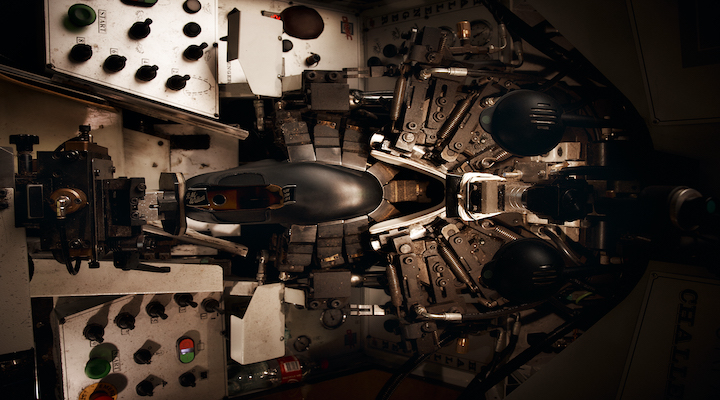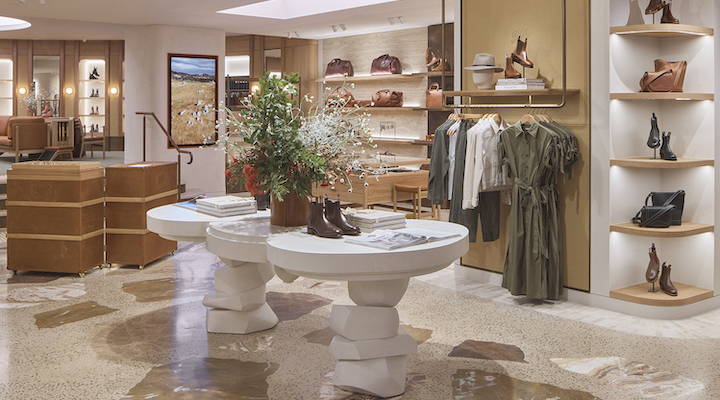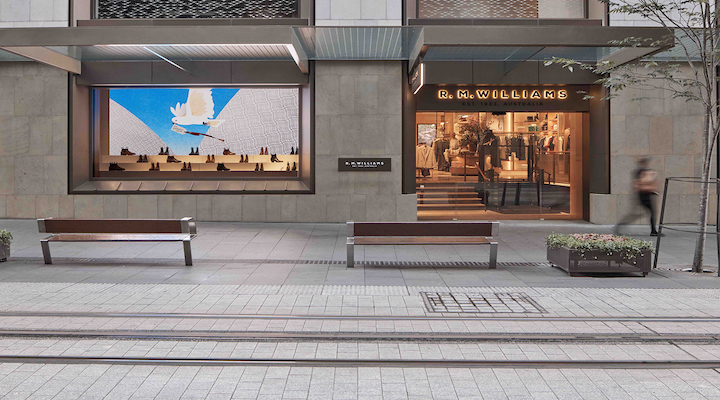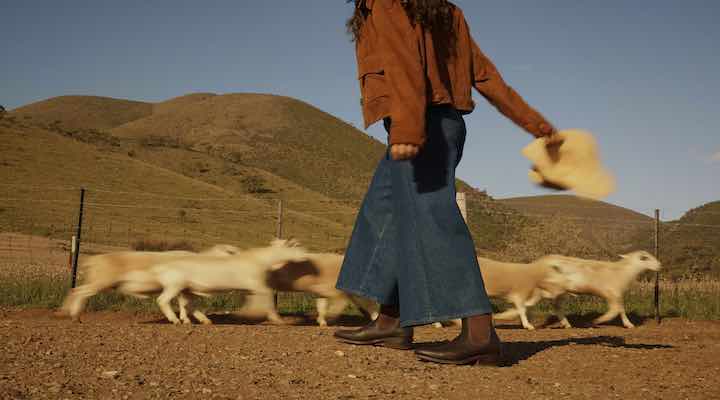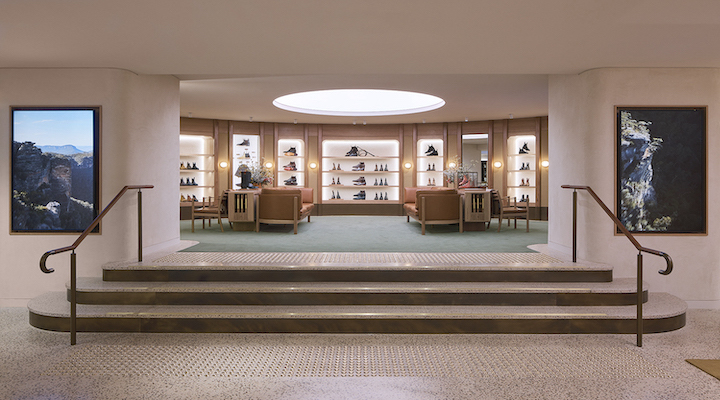Investing in its people and technology to give the customer the best possible experience has been paramount for heritage Australian brand RM Williams since Tattarang, the private investment company owned by mining magnates Andrew and Nicola Forrest, acquired the business from L Catterton in 2020, returning the bootmaker to full Australian ownership for the first time since 2013. This focus can be seen in RM Williams’ global flagship store on Sydney’s George Street, which opened at the en
end of last year, revealing an industry-leading virtual showroom and customer service hub that is redefining the customer journey.
At the heart of it all are the RM Williams ethos and Paul Grosmann, who was appointed CEO in November 2021. He primarily views his role as empowering his team to best serve the customer as custodians of the RM Williams business.
Tattarang’s philosophy, as defined by its founders, is to combine ethical business practices with macro philanthropy to create “an overwhelmingly powerful force for common good”. This is also a core part of the RM Williams vision of being “a place to belong” that endeavours to be accessible, relatable and authentic.
Creating a place for the consumer to belong
The Sydney flagship, located at 345 George Street, is a fusion of the brand’s history and futuristic technology, all designed to give the customer the best experience possible. The carefully curated multi-level retail portal spans 460sqm, which flows onto a mezzanine located at the back of the store, where customers can enjoy their very own ‘Cinderella moment,’ whether it be for a first pair of RM Williams boots or, like Grosmann, a 12th pair and beyond.
In 2023 alone, RM Williams opened just shy of 10 new stores in Australia, including locations at Rundle Mall in Adelaide and St Georges Terrace in Perth, in a Tattarang-owned building. An international UK flagship is also in the works, to complement two current stores on New Bond Street and in Soho. So George Street is hardly RM Williams’ only new shop, but it is the standard.
“George Street is our pinnacle expression of the brand and was conceptualised to elevate how we’re showing up to our customer, whether they are physically in-store or virtually,” Grosmann told Inside Retail.
The ground floor of the flagship is dedicated to the physical customer, while level two is for the virtual shopper. The store’s virtual showroom, dubbed ‘The Homestead’, reflects how important omnichannel is for RM Williams. It fuses technology and human touch in a virtual retail space that is at the forefront of customer service innovation.
The Homestead: Human touch powered by technology
The intention of The Homestead is to further nurture the brand’s relationship with its existing customers, while simultaneously fostering new ones and equipping the brand’s customer service team to provide a bespoke shopper experience regardless of geographical location. The purpose-built digital showroom offers virtual boot-fitting and personal shopping services, providing customers with real-time style and fit advice in a way that is synonymous with the physical retail environment.
Emily Anders, RM Williams’ head of digital, told Inside Retail, “Customer service does not have to be a figment of the imagination, squirrelled away in a dark room. It can be celebrated and it can be just as visible and present as a retail store to the customer.”
RM Williams is a customer-first brand, and the virtual showroom is a physical manifestation of this and represents a culmination and celebration of the brand’s journey. “The space. for us. is a fundamental step to fortifying the path we’ve taken and making our customer purpose clearer,” Anders said.
The focus on personal service can further be seen on the iconic tag attached to every pair of RM Williams boots, which includes the address of the brand’s first factory, 5 Percy Street, letting customers know where to send their boots for repairs if needed, and grounding the brand in place and time. The brand’s namesake founder, Reginald Murray Williams, was famous for saying,“It’s the people that make the company” and that is a core part of The Homestead’s DNA.
“It’s important to remember we’re humans and that’s at the essence of what we present,” Anders said.
Here is another place where technology boosts customer service. RM Williams is working with Powerfront, a software company, to provide the live chat and gamified floor-to-ceiling video display that shows all customers on the brand’s site and their real-time activity. This allows the team to intercept any issues and further enhance the customer experience globally from the brand’s flagship retail space.
The technology leverages artificial intelligence to communicate the customer’s intent and emotions, enabling the human team to work as efficiently as possible.
Digital plays a role in everything RM Williams does. For instance, the brand’s recent ‘Mark of an Icon’ campaign on Sydney’s Pitt Street Mall used QR codes to invite people to “immerse themselves into the brand and the following day make their way into the store for the actual Cinderella moment”, Anders said.
QR codes are also used throughout the store to help customers connect with the story of RM Williams, and the brand is pursuing more ways to add a digital layer to all touchpoints of the customer experience.
Crafting a better future
RM Williams is embracing digital to enhance the customer journey and remains committed to ‘crafting a better future’ through quality craftsmanship, durability, inclusivity and a celebration of the Australian spirit. “It’s not just about what we’re making, it’s also important as to how we’re making it,” Grosmann explained.
Sustainability is now a part of this commitment. The business has defined three key sustainability goals: sourcing regenerative and responsible fibres, improving the circularity of materials, and cultivating craftsmanship. Digital does have an important role in this strategy – providing transparency and trust when communicating progress.
So far, the brand has made the most progress in shifting to preferred fibres and materials. This includes eliminating plastic from product packaging and continuing to innovate and explore the use of new materials to craft products.
The recycling program, which didn’t exist a year ago, facilitates the first step towards circularity by allowing customers to drop off their old boots to be refurbished and sold at heavily discounted prices in exchange for a voucher. Boots that are past the point of repair are sent to the brand’s recycling partner Tread Lightly and repurposed.
Power to its people
RM Williams is also backing up its talk about the importance of its people with investment. It is seeking to provide the best customer experience in the world by maximising the capabilities of its staff. One example of this is the immersion trip that all eight members of The Homestead team took to the brand’s South Australian workshop, where they saw first-hand how each pair of RM Williams boots is crafted by 80 pairs of hands and passed through 68 stations before being fit for sale.
Equipping the team with a deeper knowledge of the brand’s craftsmanship and heritage has enabled them to communicate this to customers and enrich the virtual and physical shopping experience.
Notably, this initiative was not directed at executive staff, but rather the people interacting with customers daily, and the brand has plans to proliferate it to other employees.
RM Williams’ signature service principle is grounded in product mastery, empathy and connectivity with the customer. Having worked in frontline retail herself, Anders believes that the way the brand supports customer-facing retail staff is paramount.
“We’re trying to be gamechangers in the way we invest in our people so that investment is then passed on to our customer,” Anders explained.
Also at the workshop in South Australia, RM Williams has introduced Certificate III apprenticeships for the first time in 15 years, to further cultivate its investment in craftsmanship, alongside navigating new production capabilities.
Steve Moore is a master craftsman, one of six in the brand’s history, and the current most senior bootmaker, who has been crafting RM Williams boots at the Salisbury workshop in the Northern Suburbs of Adelaide for 27 years. Moore believes human hands are the best tools to work with the natural character of the leather and feels a great sense of privilege each time he signs a pair of boots.
For Anders, stories such as these are worth their weight in gold and are an important part of “how we reinforce that we are the best in the world”.
“My role is providing a window into the beautiful craftsmanship, heritage and iconicity,” she said. “Deepening exploration into our icons and taking ownable authority in well-made, enduring clothes, boots and accessories – that’s what excites me. There’s so much innovation and investment into the business and a big part of that is the people. Growing internationally and locally, in Australian-made, and working with the leadership that is Paul Grosmann and Steven Woolley, our Chief Commercial Officer, with the strong support of our owners and the board through Tattarang – it’s a very rare experience.”
Part of that well-made heritage is a tailored made-to-order (MTO) offering. Its upcoming reintroduction will allow customers to create bespoke boots using exotic materials such as crocodile and ostrich leather. The program’s functionality will be facilitated by the digital team, like the MTO belts program, which is operating in the George Street flagship.
“The crocodile and ostrich leather are certainly part of the brand’s DNA, [along with] the ability to make a boot that is uniquely yours. We’ve started with the MTO belts program. To have your fingerprint and build something that is so custom and bespoke is very important and it’s a digital-first,” Anders said.
Grosmann’s service-based leadership is a perfect fit
CEO Grosmann’s own love for the brand and Tattarang’s ownership are what excited him to relocate home to Australia from Asia, where he had been the VP/GM of Nike Direct Stores in Greater China.
“They have this incredible balance of being both passionate about the brand, highly ambitious and willing to invest to make meaningful change, that’s a really rare combination,” Grosmann said about Tattarang.
He views it as the collective responsibility of the leadership team to preserve the brand’s 92-year heritage, craftsmanship and stylish versatility, whether by transforming production, international expansion or continually elevating the RM Williams product.
He is an advocate of the servant leadership philosophy and steers his team with a focus on how he can support them in being their best, inspired by his mentor, Brett Blundy, the founder of private investment company BBRC and Lovisa.
“Brett Blundy is, I would argue, Australia’s best retailer. He and Shane Fallscheer are two of the most inspiring retailers that I’ve had the privilege of working for, both are extraordinary operators,” Grosmann said.
The natural evolution of a business that occurs with a change in leadership is inevitable. RM Williams’ current business operations and growth ambitions differ significantly from those under the previous ownership. There has been a complete change in the leadership team and how it is structured since the Tattarang acquisition, a process in which Grosmann played a pivotal part. And the changes continue.
“We’ll include Nicola Forrest or John Hartman, who is the CEO of Tattarang, for certain hires, to gain their perspective on whether they see the right cultural fit and ability. It’s not an individual process. Support from the leadership and ownership teams in hiring decisions, I believe, is critical to getting it right,” Grosmann said.
On top of this, sales are moving in the right direction, with RM Williams reporting $192 million for the year to June 2021, a 26 per cent increase on the prior corresponding period.
Also, the company returned to a net profit, of $36.8 million, up from a $2.3 million net loss in the prior corresponding period.
Coming home to Australian ownership resonated well with the local market, as domestic revenue increased from $139 million in 2020 to $178 million in 2021. Global sales also grew from just shy of $9 million to roughly $9.6 million and will continue to be a key focus for the business.
Dressed for service with Akubra
Tattarang’s acquisition of hat brand Akubra in November 2023 has raised the prospect of future collaborations between the two heritage brands.
Like RM Williams, Akubra has a long history of family ownership and commitment to local Australian manufacturing. It has also long been the only third-party brand stocked by RM Williams. The intertwined history of the two Australian heritage brands dates back over half a century; there’s even an Akubra-made, RM Williams-branded hat.
“There’s an incredible fit between Akubra and RM Williams and that’s a truly authentic relationship between the brands. We share many of our customers and there’s a high level of crossover,” Grosmann said.
With the ink still drying on the contract, he said, “I can only imagine that we will not just continue that journey together, but find ways to create an even stronger connection. I don’t know what that looks like yet, just that there is always going to be a home for Akubra in an RM Williams store.”
This story first appeared in the February 2024 issue of Inside Retail Australia magazine.

